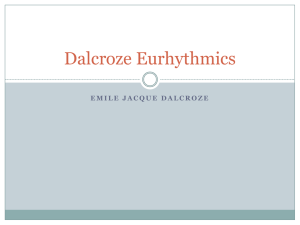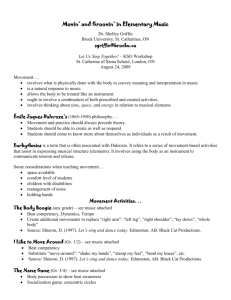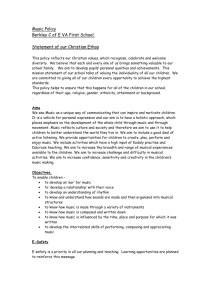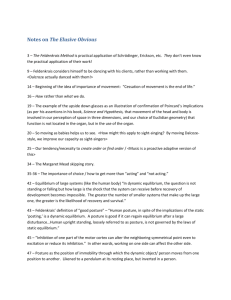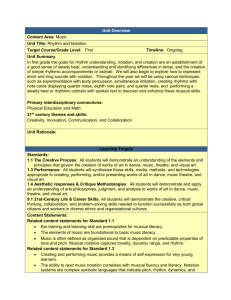The Social Economic and Environmental Impacts
advertisement
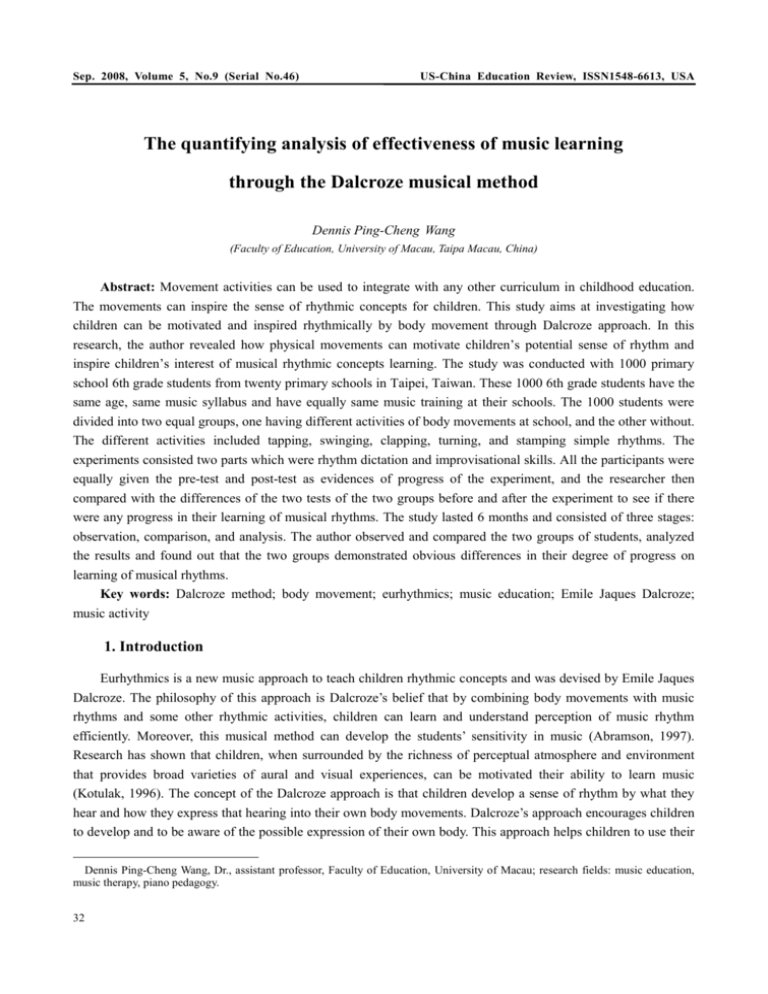
Sep. 2008, Volume 5, No.9 (Serial No.46) US-China Education Review, ISSN1548-6613, USA The quantifying analysis of effectiveness of music learning through the Dalcroze musical method Dennis Ping-Cheng Wang (Faculty of Education, University of Macau, Taipa Macau, China) Abstract: Movement activities can be used to integrate with any other curriculum in childhood education. The movements can inspire the sense of rhythmic concepts for children. This study aims at investigating how children can be motivated and inspired rhythmically by body movement through Dalcroze approach. In this research, the author revealed how physical movements can motivate children’s potential sense of rhythm and inspire children’s interest of musical rhythmic concepts learning. The study was conducted with 1000 primary school 6th grade students from twenty primary schools in Taipei, Taiwan. These 1000 6th grade students have the same age, same music syllabus and have equally same music training at their schools. The 1000 students were divided into two equal groups, one having different activities of body movements at school, and the other without. The different activities included tapping, swinging, clapping, turning, and stamping simple rhythms. The experiments consisted two parts which were rhythm dictation and improvisational skills. All the participants were equally given the pre-test and post-test as evidences of progress of the experiment, and the researcher then compared with the differences of the two tests of the two groups before and after the experiment to see if there were any progress in their learning of musical rhythms. The study lasted 6 months and consisted of three stages: observation, comparison, and analysis. The author observed and compared the two groups of students, analyzed the results and found out that the two groups demonstrated obvious differences in their degree of progress on learning of musical rhythms. Key words: Dalcroze method; body movement; eurhythmics; music education; Emile Jaques Dalcroze; music activity 1. Introduction Eurhythmics is a new music approach to teach children rhythmic concepts and was devised by Emile Jaques Dalcroze. The philosophy of this approach is Dalcroze’s belief that by combining body movements with music rhythms and some other rhythmic activities, children can learn and understand perception of music rhythm efficiently. Moreover, this musical method can develop the students’ sensitivity in music (Abramson, 1997). Research has shown that children, when surrounded by the richness of perceptual atmosphere and environment that provides broad varieties of aural and visual experiences, can be motivated their ability to learn music (Kotulak, 1996). The concept of the Dalcroze approach is that children develop a sense of rhythm by what they hear and how they express that hearing into their own body movements. Dalcroze’s approach encourages children to develop and to be aware of the possible expression of their own body. This approach helps children to use their Dennis Ping-Cheng Wang, Dr., assistant professor, Faculty of Education, University of Macau; research fields: music education, music therapy, piano pedagogy. 32 The quantifying analysis of effectiveness of music learning through the Dalcroze musical method bodies as easily as their own voices (Landis, 1972). Moreover, the method encourages students to feel the rhythm, such as time, metrics, pitch and pulsation and to develop these concepts into their own rhythmic expression. At this point of the learning process, listening becomes the center of learning, because the children have to phrase the beat and music which they have heard in the process into their own body movement. Therefore, the whole process of learning involves hearing, understanding, improvisation and physical interpretation (WANG, 2003). 2. Methodology The purpose of this study was to prove the effect of learning music rhythm using the Dalcroze approach in Chinese society. The goal was to determine whether the music learning taught through the Dalcroze approach can significantly help children with rhythmic learning as compared to children without having such training in Asia. The sample for this research was one thousand randomly selected students enrolled in the first semester (Fall, 2007) of their sixth year at elementary school in the year 2007. The students came from the urban school district of Taipei, Taiwan, and were the age of 12 by December 2007. All of the one thousand students participating in this experiment were native Taiwanese and they accepted the experiment throughout the whole test period of six months. These 1000 6th-grade students were the same age, studied the same music syllabus and had the same or equal amount of music training at their schools. 3. Design The design for this study was that the 1000 randomly selected students were divided into two groups of equal size, one group being exposed to different music activities of body movements at school, and the other group did not experience these activities. All the participants were given the same pre-test and post-test to measure the progress of the experiment and the researcher then compared the differences between the two tests of the two groups before and after the experiment to see if there was any progress in their learning of musical rhythms. Between the pre-test and post-test, the five hundred participants received six months of twice weekly 50-minute periods of music training with the Dalcroze approach, and the other five hundred participants had traditional and ordinary music singing instruction. The study lasted over a period of six months and consisted of three stages: observation, comparison and analysis. Both the pre-test and post-test of all of 1000 participating students were evaluated on how well the participating students performed on the “rhythm dictation” (Appendix). The music training included steady beat, meter, rest, duration, and rhythmic patterns. And students were asked to play along with the played music and were instructed by the music teachers to see whether the students clapped, stamped and bounced the balls on the exact underlying beat in the movement activities. The design of both tests for the two groups used exactly the same questions so that the results were fair and apparent. The researcher compared and analyzed the results of both these tests to measure the differences between the two tests of the participating students at the end of the experimental period as evidence of the efficiency of the Dalcroze approach. The experimental group A, which was exposed to the Dalcroze approach to music training, was involved in various music activities including tapping, swinging, clapping, turning, and stamping simple rhythms along with the played music. Also, the perception of fast and slow, loud and soft, and high and low were included in the experimental activities, while group B, was exposed only to a traditional music training of singing songs from text books without any involvement of body movement and music activities. It was anticipated that group A would 33 The quantifying analysis of effectiveness of music learning through the Dalcroze musical method demonstrate significant progress on the post-test by the end of the six months experimental period. However, if both experimental groups displayed similar progress by the end of the experiment, the researcher would prolong the period of the experimental time. 4. Observations The purpose of this study was to prove the effect of learning music rhythm with the Dalcroze approach on the randomly selected 6th-grade elementary students in Taipei, Taiwan. The goal was to provide evidence that music learning taught through the Dalcroze approach can significantly help children’s rhythmic learning as compared to children without benefit of such training. The number of the participating students in both group A and group B were divided equally into groups of the same size, 20 students per class and total 25 classes for each group during the entire experiment. Emile-Jaques Dalcroze utilized the introduction of pitch into the content of rhythm; therefore, the researcher started with the first recording of the Chinese folk song “Rainbow Sister” as a music activity to measure discrimination between high and low in music for group A. The group A students were asked to demonstrate raising by up on their heels when they heard the high notes and squatting down on their heels when they heard the low notes. The students picked up their feet, jumped and crouched on their heels during the playing of the music. Also, students demonstrated their awareness of changes in tempo in the music. In addition, the students were asked to walk around the music classroom following the dynamics played in the recorded music in this music. On accented sounds, students were asked to move further forward while on softer sounds, students were required to move in smaller steps, so distinguishing, by the length of their forward movements their appreciation of stressed and softer sounds. The “inner hearing” is one of the important features of Dalcroze music method. Carefully listens to a pitch, sings inside and comprehends the tone in one’s mind without singing out loud can both enhance children’s perception of music tone and stimulate children’s sensitivity to a pitch (Mead, 1986). This research also included the “inner hearing” as part of the training and experiment. The second selection of recorded music was the well-known children’s nursery song, Twinkle, Twinkle, Little Star to asses the training of “inner hearing” for this part of the experiment. The students were required to remain silent whenever the “la” and “sol” notes appeared in the song. Students were next engaged in singing the complete song, Twinkle, Twinkle, Little Star, along with body movement, such as clapping, and snapping on the 2nd and 3rd beat of the music (Figure 1). The purpose of this activity is not only to help students sing the pitches of the 2nd and 3rd beat in silently in their won minds, but also to develop a concrete understanding of what the exact pitches were after all the 2nd and 3rd beats in the song; and the exercise can also train students to clap and snap on the correct beat and so improve students’ ability to interact with other students. According to Dalcroze: Body movement is the predominant experience, but listening is the key to this experience since the individual’s sensitivity to sound determine the sensitivity of the physical response. It is what the person is feeling that is important. The development of musical thought and feeling must come together (Jaques-Dalcroze, 1967, p. 121). Moreover, the clapping and snapping activity not only helped the participating group A students have a better understanding of the underlying beat along with the music played but the exercise also provided the function of coordinating students to utilize their different body movements under the steady beat and music. 34 The quantifying analysis of effectiveness of music learning through the Dalcroze musical method (A) Original Music: Melody 1 1 5 5 6 6 5 ---- 4 4 3 4 4 3 2 2 1 ---- (B) Original Music with Body Movement: Snap 1 1 Clap X X 5 --- X X Figure 1 X X 1---- X X Twinkle, Twinkle, Little Star The third and fourth pieces of music played by the researcher were In the Hall of the Mountain King by Edward Grieg and Oh, Susanna. The students were asked to pass an assigned small percussion instrument to the person sitting next to them around the circle of the class on the exact 1st beat of every fourth beat during the playing of the music. The training was focused on their discrimination between fast and slow in music. In order to help students have a concrete sense of the beat and 6/8 time meter, the researcher used Take Me out to the Ball Game and A Bicycle Built for Two that were the 5th and 6th selected recordings. The music instructor assigned every fourth student in each row and each of the participating students was given a basketball and was asked to bounce the basketball on the floor on the exact 1st beat of every 3 beat (Figure 2). In the next rhythmic exercise, the music teacher assigned every 6th student in each row and each student in these rows was asked to take turn bouncing the basketball in order, while the music was playing and following the rhythm; i.e. the 1st student bounced the ball on the 1st beat, the 2nd student bounced the ball on the 2nd beat, the 3rd student bounced the ball on the 3rd beat…etc. A B C D Figure 2 A B C D Take me out to the ball game In addition, the students were asked to stamp with their right feet and left feet on the floor when they heard the 1st beat and the 4th beat of the played music. The purpose of the activity can not only motivate students’ understanding of the down beat and musical phrase, but the activity can also help students to be aware of the rhythm in music. The next selection of the music was Canon in D by Pachelbel and The Second Movement of Winter from The Four Seasons by Vivaldi. The students were grouped in pairs and sat on the floor in the classroom. Each pair of students was given a basketball and asked to gently roll the balls to the other side to their partners on every 4th beat during the music played (Figure 3). According to Dalcroze: Although rhythm is physical in origin, the body and brain must work together at all times. In a sense, the musical instinct and the musical intellect are developed together. Thus, all exercises are aimed at the growth of the body and the mind as well as the coordination and harmony between the two (Wax, 1979, p. 6). A ------------------------------------B Figure 3 B---------------------------------- A Canon in D 35 The quantifying analysis of effectiveness of music learning through the Dalcroze musical method The researcher believes that not only did students benefit from both feeling the music phrase and rhythm by gently rolling the ball to their partners, but the students can also sense the harmonious flow. In order to maximize the result of the exercise, it is suggested the soft and slow music be played so that the musical instinct and the perception of music sensitivity of the participants can be fully developed. Moreover, the students were asked to “mirror”, “shadow” and “contrast” their partners’ body movement as they were assigned in pairs when The third movement of Autumn from The Four Seasons by Vivaldi was played. Each pair of participants was allowed to take turns and freely express any body movements while their partners were asked to imitate their parterres’ movement in every 4 beats of the played music. The research believes that this activity can stimulate the students’ creativity and sensitivity to music. 5. Results Much research has shown the evidence of learning musical rhythm contains the keys to all learning. Moreover, the music teachers have been seeking various ways in order to provide students with the most efficient music approach in the limited time of music learning (Berchtold, 1965). The result of this research gives the music teachers a guide to methods of teaching. After six months of the Dalcroze music approach training, the result of the post-test of group A students demonstrated a significantly better score over the group B students who had only been exposed to traditional singing and music instruction. Moreover, comparing both pre-test and post-test of the group itself, group A students showed the apparent progress between two tests while group B showed less progress in their two tests. The author observed and compared the two groups of students, and analyzed the results of both pre-test and post-test and these are listed as below (Table 1). Table 1 Question Q1 Q2 Q3 Q4 Q5 Q6 Q7 Q8 Q9 Q 10 Q 11 Q 12 Q 13 Q 14 Q 15 Q 16 Q 17 Q 18 Q 19 Q 20 36 The comparison of the post-test result for group A and group B Group A 78 76 82 80 82 86 81 88 83 86 81 90 72 70 71 69 71 68 88 89 Group B 68 65 70 64 59 69 62 57 65 69 70 72 59 61 63 59 63 60 62 62 The quantifying analysis of effectiveness of music learning through the Dalcroze musical method First of all, the results of the post-test for both group A and group B have shown these significant differences. Not only did group A demonstrate remarkable results on the post-test over group B, but the results of both pre-test and post-test also revealed significant progress for group A (Table 2). By analyzing the results of the post-test for both experiment groups, the researcher found that after an experiment with the Dalcroze music training method, group A had a better understanding of organizing the beats and rhythm, while group B had not shown much progress in this area according to the two tests. This result can be proved by the Q.4-12 where the questions all contained a series of different regular patterns of the rhythms. Moreover, the researcher noticed that group A demonstrated major progress in Q.1-3 from both tests which contained the regular steady beat rhythm; the researcher believes that group A had imperceptibly adapted the steady beat in their minds after the period of the Dalcroze music approach which focused on the steady beat in the music activities. The Q.13-18 were the random irregular rhythms which did not have regular rhythmic patterns and the results reflected less understanding for both groups. However, although the results showed a less impressive performance, group A still performed better than group B and showed major progress between pre-test and post-test. The Q.19-20 were in the meter of 6/8 which contained waltz-like rhythmic patterns. As expected, group A demonstrated major progress on both questions and better performance than group B. Table 2 The comparison of the pre-test and post-test for group A Question Pre-test Post-test Q1 64 78 Q2 66 76 Q3 72 82 Q4 62 80 Q5 56 82 Q6 72 86 Q7 63 81 Q8 59 88 Q9 68 83 Q 10 62 86 Q 11 66 81 Q 12 70 90 Q 13 55 72 Q 14 64 70 Q 15 60 71 Q 16 62 69 Q 17 66 71 Q 18 64 68 Q 19 64 88 Q 20 66 89 37 The quantifying analysis of effectiveness of music learning through the Dalcroze musical method 100 100 80 60 40 20 0 The Result of Post-Test for Group A 80 The Result of Post-Test for Group B 40 Q1 Q3 Q5 Q7 Q9 The comparison of the post-test result Figure 4 The Result of Post-Test for Group A 60 The Result of Post-Test for Group B 20 0 Q11 Q13 Q15 Q17 Q19 Figure 5 Q.1-Q.10 for group A and group B The comparison of the post-test result Q.11-Q.20 for group A and group B 100 100 80 80 60 Group A PreTest 60 Group A PreTest 40 Group A PostTest 40 Group A PostTest 20 0 Q1 Q3 Q5 Q7 Q9 Figure 6 The comparison of the pre-test and post-test Q.1-Q.10 for group A 20 0 Q11 Q13 Q15 Q17 Q19 Figure 7 The comparison of the pre-test and post-test Q.11-Q.20 for group A 6. Conclusion and recommendations The central principle of the Dalcroze music approach focuses on students’ spatial orientation and harmonious flow along with music. Emile-Jaques Dalcroze combined locomotion, body movement and improvisation in his music approach. In this research, the physical movement followed by the recorded music was examined and proved its efficiency on music learning. Students were aware of themselves and surrounding environment in the music classroom. Moreover, the approach combines both body movements and music so that students can understand different rhythmic concepts imperceptibly during the music activities (Choi, 2001). The Dalcorze method also involves silence and isolates different parts of the body during the exercises while other music methods focus on moving and continuity. This provides students with the means to release tension and to sense the tension of their bodies. Also, the concept grants students the importance of the rest in music which is often neglected by many students (Mead, 1996). Locomotion, such as walking, galloping and stamping, gives students the idea of a steady beat and balance in music. According to the experiment, the result showed the students made significant progress in the steady beat and down beat of the rhythmic concept after the period of the Dalcroze music training. The researcher certainly believes that constant music training with a series of rhythmic activities and locomotion in the music class can help students’ better understanding of learning different rhythms and meters efficiently. Moreover, the music approach can motivate students’ interests in learning music and make 38 The quantifying analysis of effectiveness of music learning through the Dalcroze musical method the music lesson become more enjoyable and understandable by both two groups of students (YANG, 2001). The researcher suggests that in order to release most of the elementary-school-level students’ active personalities in the classroom, the music teacher can choose music activities with large motions involved in their music classes, such as galloping, walking and stamping…etc. And because young students like to imitate teachers, the music teacher can wisely utilize the movement technique of mirroring and shadowing along with played music in the class so that students can combine both playing and learning at the same time (Gary, 1967). Despite the rapid growth of the Dalcroze music method by music teachers into their music classrooms internationally, the required musical facilities, equipment and necessary training, this method is insufficiently known and applied around the world. The researcher suggests that it is important to hold more Dalcroze music method workshops and teachers’ training on campus and to promote the efficacy of this music approach. Furthermore, and despite the central principles and the pedagogical aspects of the Dalcroze music method having shown clear evidence on learning music efficiently, research and experiments are still insufficiently utilized in general music classrooms at all levels. Similar experiments need to be encouraged and allowed by the schools at all levels. At least cross-cultural music studies and alternation of different national folk songs need to be encouraged and implemented as tools of the Dalcroze approach internationally in order to promote and maximize the efficiency of the music approach. References: Abramson, R. M. (1997). Rhythm games for perception and cognition. Pittsburg, PA: Volkwein Bros. Berchtold, A. (1965). Emile Jaques-Dalcroze et son temps. In: F. Martin. (Ed.). Emile Jaques-Dalcroze l’homme, le compositeur, le createur de la createur de la rhythmique. Neuchatel, Swizerland: L’editions de la Baconniere. Choi, So-Hee. (2001). A study about the teaching method of chang-dan based on the eurhythmics concept by Dalcroze: Focus on the model of 5-6 year old. (Doctoral dissertation, Dankook University) Gary, L Charles. (1967). The study of music in the elementary school—A conceptual approach. Washington, D. C.: MENC. Gardner, Howard. (1983). Frames of mind: The theory of multiple intelligences. New York: Basic Books. Gordon, E. Edwin. (1998). Music play: The early childhood music curriculum guide for parents, teachers, and caregivers. GIA Publication, Inc., Chicago. Hanses, Kristen S. A. (2006). Musical game for every age-group. Teaching Music, 9(1). Jaques-Dalcroze, E. (1924). Rhythm, music and education. New York: G.. P. Putnam. Jaques-Dalcroze, E. (1967). Rhythm, music and education. Harold Robinstein. (Tran.). New York: G. P. Putnam. (Original Work Published 1921). Joseph, Annabelle Sachs. (1982). A Dalcroze eurhythmics approach to music learning in kindergarten through music movement, ear-training, and improvisation. Doctoral dissertation, Carnegie-Mellon University. Johnson, Monica Dale. (1993). Dalcroze skills of all teachers. Music Educators Journal, 79(8). Mead, H. Virginia. (1986). More than mere movement: Dalcroze eurhythmics. Music Educators Journal, 72(6), 42-46. Swaiko, Nancy. (1974). The role and value of a eurhythmics program in a curriculum of deaf children. American Annual of the Deaf. (119), 321-324. Yang, See Young. (2001). A Study on the usage and teaching method of Emile-Jacques Dalcroze’s in music of education. (Doctoral dissertation, Kwan Dong University) WANG, Dennis P. C. (2003). Creative approaches to children music education. Quantum Press. Wax, Edith. (1979). Dalcroze dimientions. New York: Mostly Movement, LTD. Zachopoulou, Evridiki, Vassiliki Drri, Dimitris Chatzopoulou & Theordoros Elinoudis. (2003). The application of Orff and Dalcroze activities in preschool children: Do they affect the level of rhythmic ability? Physical Education, 60(2), 51-59. (Edited by Lily and Nydia) 39 The quantifying analysis of effectiveness of music learning through the Dalcroze musical method Appendix: Pre-test and post-test 1. 2. 3. 4. 5. 6. 7. 8. 9. 10. 40 The quantifying analysis of effectiveness of music learning through the Dalcroze musical method 11. 12. 13. 14. 15. 16. 17. 18. 19. 20. 41
